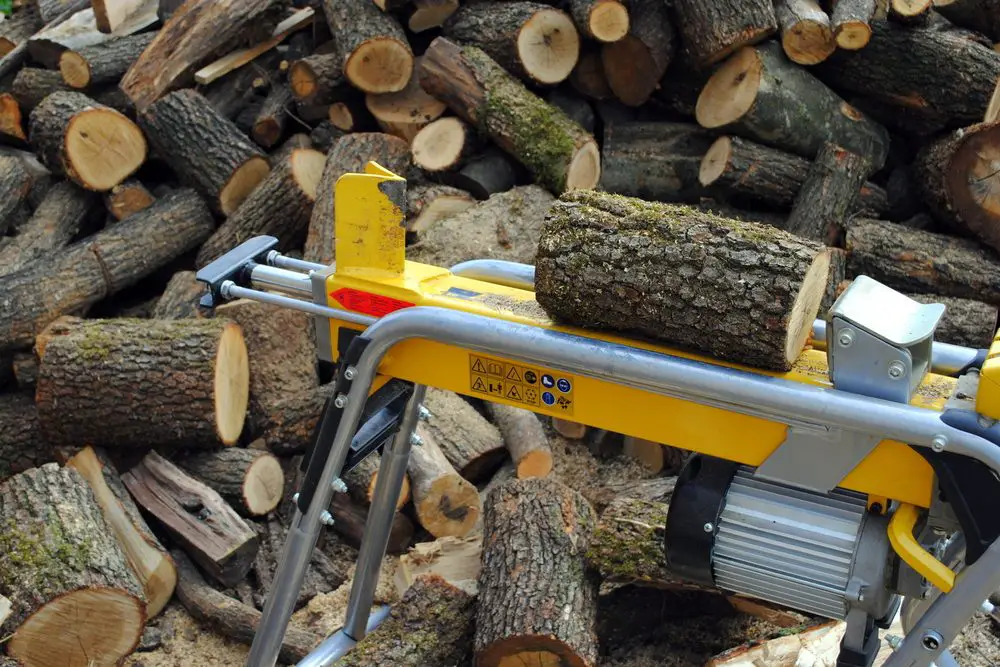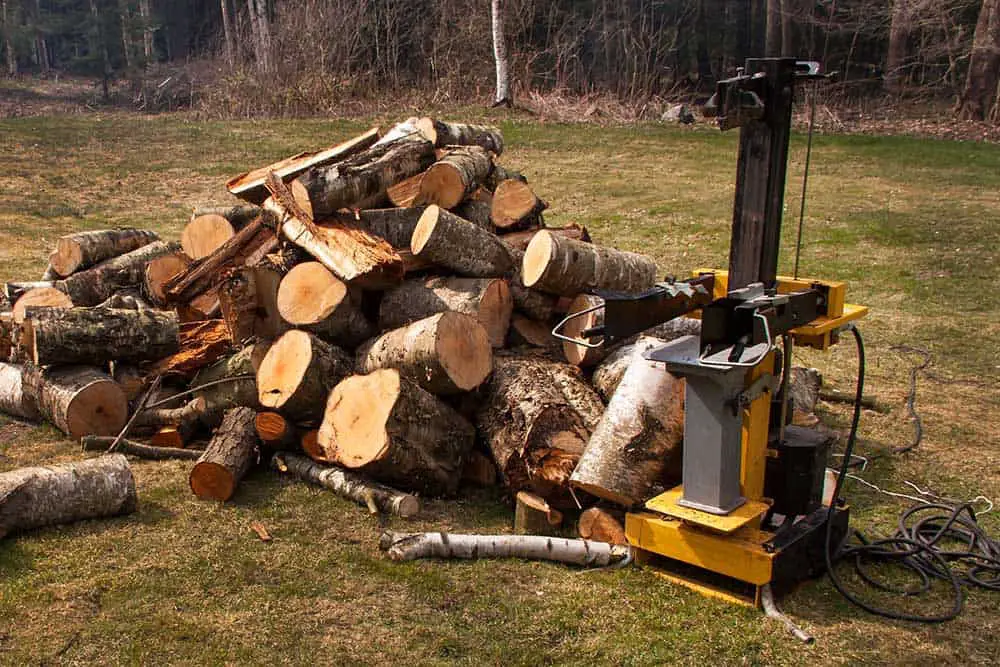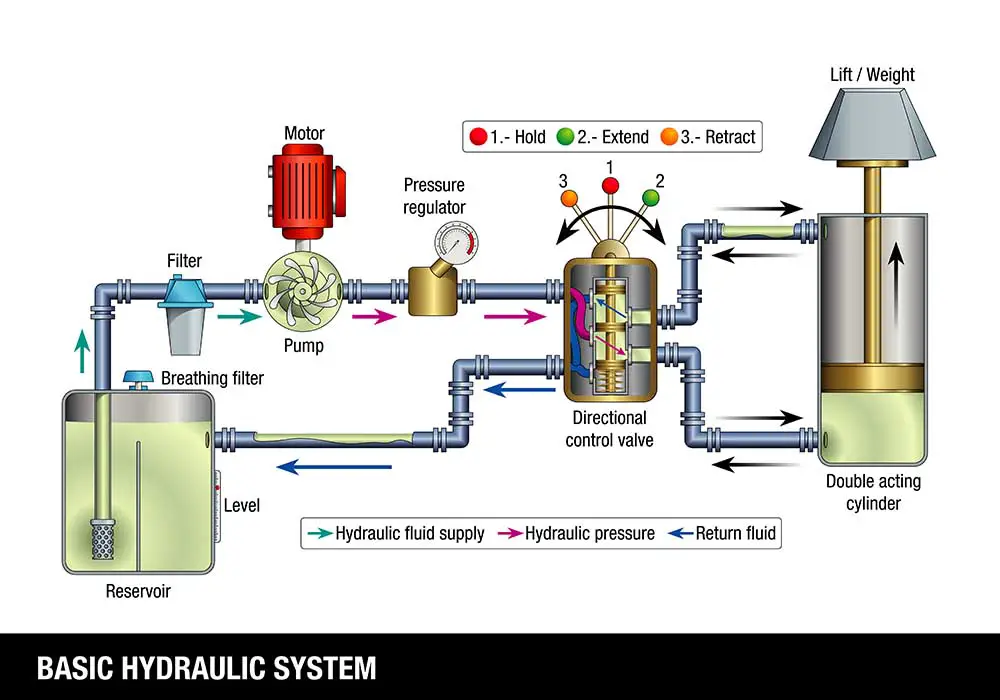Splitting logs the old-fashioned way with an axe can be a very enjoyable activity, but it’s physically demanding and not very efficient.
If you’ve got a lot of logs to process, the only logical solution is to use a log splitter.
Log splitters speed up the task at hand exponentially and save your back in the process, but how exactly do they work?
You wouldn’t be the first one to wonder how these mechanical marvels get the job done. Not to worry though. In this article, we’re going to cover all the essentials and bring you up to speed.

What are the Different Types of Log Splitter
You’d be forgiven for thinking a log splitter is a log splitter and that’s that, but there are actually three different types of log splitter: manual, hydraulic, and kinetic.
Each of these has certain benefits and limitations. To decide which one, if any, is right for you, you’ll need to think carefully about what you require from a log splitter.
Let’s discuss each type individually…
Manual Log Splitters
By far the most simplistic of the bunch, manual log splitters are technically also hydraulic mechanisms, but their power is built up by the user rather than a motor.
Available as foot or hand-operated units, they work in a similar fashion to a car jack.
Foot-Operated
Some foot-operated log splitters are vertically oriented, but most are floor-bound mechanisms usually just over a meter in length. They normally consist of a foot pedal, a hydraulic pressure plate, a loading platform, and a splitting wedge at the opposite end.
Once a log is loaded onto the platform, the base against the pressure plate, you simply use the foot pedal as if you’re inflating an airbed. The hydraulics kick into action, and with every step, the pressure plate inches the log towards the splitting wedge.
Eventually, enough force builds up between the log and the wedge that the log splits clean in two.
There are even very basic foot-operated log splitters that don’t rely on hydraulics at all and instead use a rail system to force the log into the splitting wedge.
Level-Operated
Lever-operated manual log splitters are essentially the same thing except you use your hands to power the hydraulic ram system. They usually come with two levers.
One lever usually moves the pressure plate quickly but with a minimal driving force, while the other moves the ram slowly but with an immense amount of pressure.
Check out one of our favorite manual log splitters here:
Sun Joe LJ10M 10-Ton Hydraulic Log Splitter
Let’s summarise with a quick manual log splitter pros and cons list…
Pros:
- Easy to Use – Not much can go wrong with this design. It’s a simple operation and they’re easy to maintain.
- Portability – They’re not exactly featherweight, but they’re certainly more transportable than other kinds of splitter.
- Affordable – Generally speaking, manual log splitters are far easier on the savings account than others.
- Exercise – While using them doesn’t require the physicality an axe does, it’s still a good bit of exercise.
Cons:
- Exhausting – You’ll definitely feel it in your shoulders or quads the next day.
- Not Too Fast – Most manual log splitters don’t get the task done much faster than an axe.
[amazon box =”B00VPJAPS2″]
Hydraulic Log Splitters
Up until fairly recently, hydraulic log splitters were the only premium option on the market, with two subtypes to choose from: electric or gas.
They work in fundamentally the same way, just with a different power source. Electric splitters are often not much larger than manual splitters, but gas splitters can be great big bits of machinery.
Electric Hydraulic
Featuring a simple button-start, the 5 horsepower electric motor kicks into action and triggers the 2-stage hydraulic oil pump.
The pump uses a pressure sensor to calculate the GPM required to either push the log into the splitter or retrieve the ram so another log can be loaded.
Once the pump calculates the necessary pressure it sends oil to the hydraulic cylinder responsible for pushing the log into the wedge.
Gas Hydraulic
Gas hydraulic log splitters are more powerful than their electric counterparts and don’t need to be plugged into an outlet, but they run on the same principles.
They have a 2-stage hydraulic pump housing two gear pumps and a bypass valve. They’re capable of both hydraulic pressure (PSI) for force and hydraulic flow (GPM) for speed.
As the log is pushed quickly into the splitter, back pressure builds to around 700-800 PSI, triggering the bypass valve in the pump. Now the larger of the gears start passing oil back into the pump inlet.
From here the small gear gets to work building the pressure for some log splitting action.
Excess oil then completes a circuit from a directional valve through a filter to ensure no particulate matter has found its way in, back into the reservoir where it is cooled and air bubbles are allowed to settle before the oil is pumped once again.
Here’s one of our favorite hydraulic log splitters for a closer look:
Champion 7-Ton Compact Horizontal Gas Log Splitter with Auto Return
Let’s distill all of this down to another digestible pros and cons list…
Pros:
- Powerful – Even the most formidable logs don’t stand a chance against these machines.
- Require Minimum Effort – All you have to do is load the log and enjoy the show.
- Fairly Efficient – Although plate retraction can be a little sluggish, this is a far more time-effective way to process a large number of logs.
Cons:
- Expense – These things are complex bits of machinery and their pricing reflects that.
- Maintenance – The more complex a system is, the more maintenance it will require.
- Portability – Although some large gas log splitters are fitted with hefty wheels, they’re not exactly easy to move around.
[amazon box =”B00BBDCGSY”]
Kinetic Log Splitters
The most recently invented of the three splitter types is the kinetic log splitter. Kinetic energy is no new-fangled concept, it’s just taking us some time to realize how it can be used in the context of a log splitter.
Also known as flywheel log splitters, kinetic splitters utilize huge flywheels to convert energy from the engine into log splintering excellence. A flywheel is a round mechanical device used to harness and store energy.
Picture an antique sewing machine. You have the foot pedal that spins the large wheel, which in turn spins the smaller wheel attached to the machine. These are flywheels. They force the pressure plate along the platform into the splitting wedge and voila! Firewood for days.
What makes kinetic log splitters so special is their speed. They can complete their push/retraction cycle in as little as 2.5 – 3 seconds, whereas hydraulic splitters tend to take around 12 – 15 seconds to reset.
This is because the flywheels are constantly building pressure before their explosive release. Then the remaining energy in the momentum of the wheels automatically retracts the pressure plate.
Here’s a kinetic log splitter that’s turning heads at the minute:
Generac WR31110ACNG 10 Ton Kinetic Log Splitter
Let’s finish things off with one last pros and cons list.
Pros:
- Speed – These things zip through logs insanely fast.
- Minimum Effort – Much like hydraulics, all you have to do is load the log.
- Fuel-Efficient – Kinetic log splitters require less fuel than hydraulic mechanisms.
- Ease of Maintenance – They require far less maintenance than hydraulic splitters and said maintenance is easier to carry out.
Cons:
- Price Tag – They’re the most expensive splitters of all.
- Strength – Kinetic splitters are only really supposed to be used for soft and medium woods. Hardwood is best left to hydraulic splitters.
[amazon box =”B08QY2HPX9″]
Final Thoughts
That’s all there is to it, folks. No longer will these contraptions confuse.
Now you’re fully informed, you can confidently decide which one is best for you and your log splitting workload.







